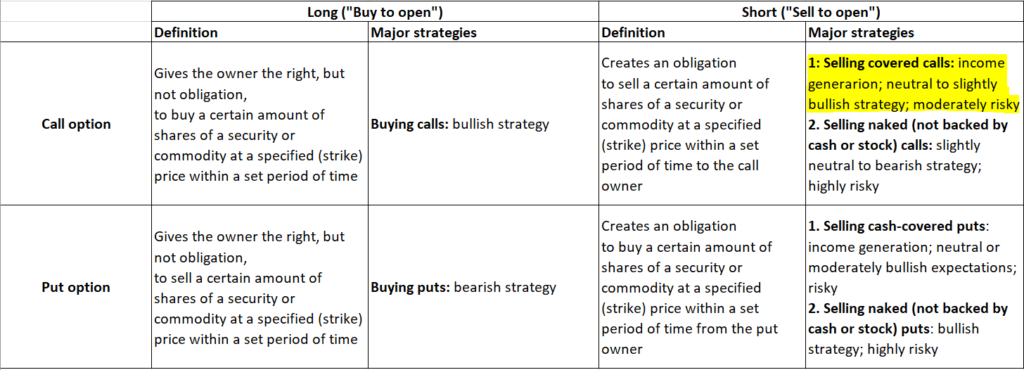Many assets lose value over time.
A new car depreciates as soon as it leaves a dealer’s lot. And as a rule of thumb, a car loses 15-20% of its value annually… until, at some point, it’s worth nothing.
An option contract also loses value over time. This phenomenon is called “time decay,” and it’s based on the fact that options have a date when they cease to exist. All else equal, the option price will decline continuously until its expiration date.
Several popular option-selling strategies are based on time decay.
My colleague Luke Downey recently discussed one of these—selling puts, a strategy you can use to purchase stocks at lower prices. A couple of months ago, I explained selling cash-secured puts, a way to use this strategy with less risk.
Today, I’ll tell you about another way to use time decay to your advantage: selling covered calls.
Covered calls, also known as “buy-write,” involve two steps: buying a security and selling (“writing”) call options against it. “Covered” means you already own the shares.
To see how it works, let’s take a quick look at call option basics.
Buying a call option gives you the right, but not the obligation, to purchase a stock at a predetermined price (the “strike” price) by a certain date (the expiration date). One option contract controls 100 shares.
Conversely, when you sell a call option, you take on the obligation to sell a security to a call owner at the strike price by the expiration date.
If you sell a covered call against your existing position, you must have the shares to deliver if the option is called.
On the expiration date, two scenarios are possible:
No. 1: The price of the underlying stock is below the strike price. In this case, the call option contract is worth zero.
No. 2: The price of the underlying stock is above the strike price. In this case, the call option is worth the difference between the stock price and the strike price.
As a call seller, you want door number one.
Ideally, the call you sold will expire worthless. You’d keep the option premium—and won’t need to deliver (sell) your shares. In sum, you benefit from time decay while keeping your stock position.
Let’s say you own 100 shares of ACME, which trades around $200 per share. You see a call option on your shares with a strike of $210 that expires in a month. The option price is $0.75. You decide to sell one contract, generating $75 on your 100 shares.
Our two scenarios:
No. 1: At expiration, ACME is trading below $210 (below the strike price). You get to keep the $75 premium you’ve collected upfront… and your 100 shares of ACME, too. In other words, you’ve made $75 extra on the stock… and can repeat the process if you like.
No. 2: ACME is trading above $210. If that’s the case, you’ll sell your 100 shares at $210—regardless of the current stock price—and keep the $75 premium, too. Your gains on ACME are capped… but you’re not losing money on this trade either.
The ideal stock action for your covered call trade would be for ACME to stay in place, decline slightly, or move moderately higher (as long as ACME trades below $210 at expiration, you’ll get to keep both the premium and the shares).
In fact, even a sharp decline in ACME is OK—as long as you don’t want to sell the stock. You get to keep the premium in either case… which could help weather the decline.
When to use this strategy
The table below gives you a snapshot of the various option strategies.

Put option buying is a bearish strategy I like to use for portfolio insurance. Call option buying is a bullish strategy best used to amplify stock or market gains.
Covered call strategies are great for stocks with limited upside… especially if you plan to hold forever.
You might have accumulated a bunch of utilities or telecoms over the years. When you think the near-term upside is limited (but don’t mind selling if shares rally), selling calls on blocks of your shares is an easy way to juice your returns over time.
If they’re called away, you can always buy more when shares decline. Meanwhile, you get to generate extra income from the same positions over and over again.
Covered calls are a good strategy for a flat or meandering market… if you’re moderately bullish on the market or a stock… or expect a slightly declining market.
High volatility also helps, since the risk involved pushes option prices higher—and many call sellers continuously scour the market for promising opportunities.
But if you don’t want to search option prices for new opportunities month after month, keep an eye on your inbox…
Next time, I’ll give you the names of unique funds you can buy outright that employ covered call strategies to enhance returns and income.
For now, remember: If you’re selling covered calls for income, time decay is your best friend. It’s a conservative income strategy that can also provide some downside protection for your portfolio.
Editor’s note:
In Genia’s investment advisory, Moneyflow Trader, she uses a combination of puts and calls to hedge against any market storm.
If you lost money in the COVID crash, this powerful strategy is for you. When the market was down 30%-plus, Moneyflow Trader members were collecting as much as 508%… from a single trade.





















